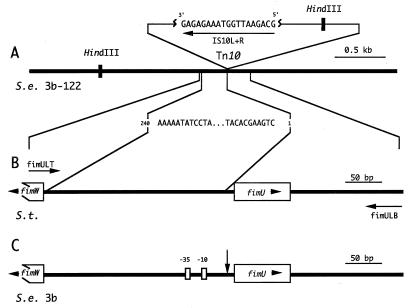FIG. 1.
Location of Tn10 on the S. enteritidis 3b-122 chromosome and identification of the genes flanking the Tn10 insertion in S. enteritidis 3b. (A) Schematic diagram of S. enteritidis (S.e.) 3b-122 chromosomal DNA (black line) showing the Tn10 insert and the strategy used to obtain the chromosomal DNA sequence adjacent to one side of this insert. A 3-kb HindIII fragment comprising 3b-122 chromosomal DNA fused to one end of Tn10 was identified by hybridization with the Tn10 oligonucleotide IS10L+R. IS10L+R was also used as a sequencing primer to obtain 240 bp of DNA sequence from the subcloned HindIII fragment. (B) Schematic diagram of the S. typhimurium (S.t.) chromosome (black line) between fimW and fimU of the type I fimbrial gene cluster that was homologous to the 240 bp of S. enteritidis 3b-122 DNA sequence. Two 42-bp oligonucleotide primers, fimULT and fimULB (horizontal arrows), were made based on the S. typhimurium sequence previously deposited in GenBank (L19338) by Swenson and Clegg (39). (C) Segment of the S. enteritidis 3b chromosome (black line) amplified by PCR with the primers fimULT and fimULB. This amplified DNA segment was subcloned and sequenced (Fig. 2) to identify the DNA flanking the Tn10 insert. The Tn10 insertion point (vertical arrow) was determined to be between the −10 region and the start of the fimU gene. The presence of fimW, fimU, and the −35 region on the 3b chromosome is also noted.

